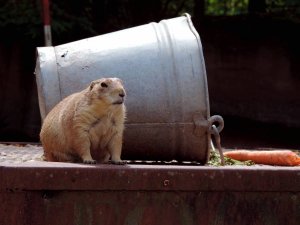The woodchuck, which is also known as the groundhog or whistle pig, is widely distributed throughout the state of Pennsylvania and Wildlife Removal Services are often relied upon to deal with the destruction they can cause to yards and surrounding landscapes.
While groundhogs do have a big day named after them in early February of every year, there is much that is not known about these odd-looking creatures that spend much of their lives underground.
Legends abound, and the ground hog folktale about predicting the weather is European in origin.
It dates back to a centuries-old German belief about weather-predicting badgers, which in the 18th century the Pennsylvania Dutch brought with them to the United States and applied to this new but similar animal.
Their compact bodies, powerful, short legs and curved claws are ideal for what they do best; namely digging deep burrows.
Groundhogs have short tails and are usually brownish gray in color. White (albino) and black critters can also occur, but they are not at all common.

Both sexes bear a similarity in appearance, albeit the males are slightly larger, weighing in on average from 5 to 10 pounds.
As is the case with most rodent species, they have chisel like incisor teeth that never stop growing. Mother Nature has endowed them with eyes, ears and noses that are located at the top of their heads, which offer the protection of allowing them to remain hidden in their burrows while peering out over the rim to check for danger from predators.
The Intricate Nature of The Groundhog Burrow
The burrow is a home, place to mate, hibernate, raise young and serves as a safe refuge from approaching danger. The main entrance is a large mound that descends at a steep angle before leveling off into a narrow tunnel.
There are actually rooms within the burrow that serve specific purposes. Sleeping and raising young is in the nest chamber, which is at the far end of the burrow.
There are also separate toilet areas, which help to maintain a clean den that perhaps even the likes of Martha Stewart would have appreciated. In addition, there are also one to three secondary entrances that are dug from below the burrow and are very well hidden.
What Kind of Damage Do Groundhogs Cause?
It is the groundhog’s eating and burrowing habits that often wreak havoc with the needs and concerns of Pittsburgh home owners who often contact Pestco’s Wildlife Removal Services division for help.
Vulnerable places are farms, home gardens, nurseries, fruit orchards, around buildings and sometimes dikes and building foundations that can be weakened by their incessant digging.
Crops can also suffer extensively as well, particularly alfalfa, beans, squash, peas and tomatoes, which are all costly to replace. Mounds of excavated burrows and holes also pose a danger to farm equipment, horses and riders.
What Is The Legal Status of Groundhogs
In the state of Pennsylvania, groundhogs are classified as game animals, but legally a home owner does have the right to shoot them if they are damaging property. While there is no “bag limit,” anyone shooting them must have a valid Pennsylvania hunting license.
Safe procedures must always be employed, and landowners/hunters can make the executive decision as to whether reducing groundhog populations or maintaining some is the best decision at the moment.
Shooting should always be a last resort after other attempts to control populations have failed.
12 Things To Know About Groundhogs
1. Groundhogs Are Known By Many Other Names
The species of woodchucks aka groundhogs (Marmota Monax) belong generally to the squirrel family, but particularly to a large group of ground rodents known as marmots.
There are many other names this creature is known by including: Canada marmot, chuck, whistle pig, which stems form the fact that they whistle to each other if danger is near, moonack, groundpig, monax, red monk, thick wood badger, weenusk, wuchak, woodshock and whistler.
2. Groundhogs Are The King Of Hibernators
Intermittently, from late fall until early spring, groundhogs enter a state of lethargy in which their body heat is reduced from 99 degrees to about 38 degrees, heart beat decreased from 80 beats a minute to 5 and breathing from 16 breaths per minute to 2.
3. They are Known For Their Large Populations
The estimated total of the groundhog population throughout the United States and Canada is over 200 million.
The clearing of the forests since the arrival of European settlers opened areas of space and farmland conducive to the survival needs of groundhogs.
4. Groundhogs Contribute To The Environment
Despite the damage they incur, groundhogs expose deep, compacted soil into the atmosphere. This provides needed oxygen to roots.
For as long as the burrows are open, they provide constant nutrients to the soil, which aids in growth of plants.
5. Their Diet Is Plant-Based
Groundhog are herbivores, and they thrive almost exclusively on fruits, berries, tree bark, twigs and vegetation.
This makes home gardens, residential yards and adjoining property and crop fields sitting targets for their sharp, sharp teeth and curved claws.
6. The Predator-Prey Groundhog Equation
Hunted extensively by humans and often prey to wolves, coyotes, bears, bobcats, eagles, great horned owl’s and others, within the natural order of things, this factor is balanced by the high reproduction capacity of the species.
One female can produce a litter of 2 to 6 pups per year, and most reach adulthood within the confines of the protective burrow.
7. The Nature Of The Burrow
In their own rodent way, groundhog burrows are splendid works of architecture. They are known to extend as much as 66 feet throughout their tunnels and chambers and as deep as 5 feet below the surface.
One study indicated that a cave excavation involving a dozen dens broke down to, in terms of numbers, each groundhog digging through an average of 384 pounds of soil and stone.
It is also not uncommon for an older groundhog to have more than one burrow.
8. Groundhog Teeth Never Stop Growing
As is the case with most rodent species, ground hog teeth grow constantly at a rate of 1/16th of an inch per week.
If teeth are nor worn down by their natural instinct for chewing, a snaggletooth or sabertooth can occur.
In some instances, tooth growth can be so excessive that it can cause them to pierce through the animal’s jaws and skull.
9. Groudhogs Have Surprising Abilities
Always wary of predators, groundhogs are excellent swimmers, as their short legs make it easy for them.
Their tails are powerful and can be used defensively, either by hitting an enemy or slamming it into the water to create an intense splash. They can swim at a rate of about 2 miles per hour.
They are also very competent climbers. They not only climb trees, as their very strong claws also allow them to easily scale pillars as well.
10. Groundhogs Have Short Lives In The Wild
Although they are known to live as long as 20 years in captivity, in the wild their average life span is between 3 to 6 years.
They cannot be owned in the state of Pennsylvania without a special permit and they do not make good pets.
Naturally aggressive, their instincts prevail over any attempts at training, and they do not adjust to life in cages.
11. A Groundhogs Burrow Once Led To An Important Discovery
In 1955, a man named Albert Miller discovered some artifacts in an abandoned groundhog burrow.
After excavating the site, the materials were sent to the Smithsonian Institute where radio-carbon dating revealed that the artifacts dated back some 19,000 years and were evidence of human habitation, most likely as a campsite.
This discovery marks the earliest known North American setting of human habitation.
12. Other Species Inhabit Abandoned Groundhog Burrows
Red foxes, skunks, opossums and rabbits are known to inhabit abandoned ground hog burrows.
While some of these species do live in holes in the ground, Mother Nature did not equip them with the claws that would aid in deep digging.
These species rely on the groundhog’s nature and ingenuity to provide their habitat.
Pittsburgh Wildlife Removal Services
Pestco Professional Services is a Pittsburgh institution, having been a part of the local landscape here since the late 1940s, servicing residences and businesses throughout all of Greater Pittsburgh and its surrounding counties. We are Quality Pro Certified and offer free estimates and guaranteed results!

In dealing with groundhogs, our approach is both effective and humane. Groundhogs can present both a health hazard as they often carry rabies as well as posing a danger to gardens, property and landscapes.
Repelling groundhogs requires professional care and know how, and our goal is always to first focus on removal rather than killing them.
Although a much kinder approach, it is also a practical one because elimination can result in dead animals that are trapped inside walls and crawl spaces, which are likely to be difficult to access. Exclusionary tactics are almost always preferred.
If groundhogs are destroying your property, call our teams today. We’re here to help!

Photo Credits: Pixabay
 Over 300 Reviews
Over 300 Reviews 